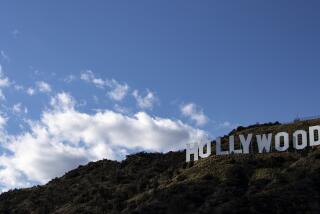How ‘Cleopatra’ Nearly Sank Fox
Martin Landau couldn’t believe his eyes. Entering the makeup trailer one morning on the infamous 1963 epic “Cleopatra,” he was surprised to see star Elizabeth Taylor sitting there. Only Landau and Richard Burton were scheduled to work that day.
“I said, ‘Good morning,’ ” recalls Landau, who played Rufio in the movie. “Then I went back to the bulletin board outside to look at the call sheet and then went back into makeup a little puzzled. What was she doing there that early?”
Landau got his answer a few minutes later when Burton, who played Marc Antony, swaggered in. “I am sitting in a chair facing a mirror and she was sitting behind me,” says Landau. “He walked in and walked up to her and kissed her--a big kiss. And then he moved up and sat in the chair next to me and said, ‘Good morning.’ I said to myself, ‘Oh, my God.’ ”
The much-publicized affair between the married Taylor and Burton was just one of the many difficulties and scandals that surrounded the making of “Cleopatra”--the most expensive movie of its day.
In fact, there seem to be more myths and legends surrounding “Cleopatra” than the actual Queen of the Nile herself. A new documentary, “Cleopatra: The Film That Changed Hollywood,” attempts to tell the real story as it examines how “Cleopatra” influenced the film industry through a $42-million budget (the equivalent to more than $200 million today) that nearly bankrupted 20th Century Fox.
The two-hour documentary features interviews with historians and participants in the movie and their families, along with recently discovered footage from the film.
“Cleopatra: The Film That Changed Hollywood” premieres at 5 and 9 p.m. today on American Movie Classics and is also featured on the new three-disc DVD of “Cleopatra” (Fox, $27), arriving in stores today. The DVD includes the wide-screen version of the original four-hour road-show version of the film, footage from the Hollywood and New York premieres, a “making of” featurette from 1963 and audio commentary from Tom and Chris Mankiewicz (the sons of writer-director Joseph L. Mankiewicz), Landau and publicist Jack Brodsky.
The documentary, says executive producer and co-director Kevin Burns, illustrates that there were no villains, only victims in the “Cleopatra” saga.
“You can’t really say what happened was anybody’s fault,” Burns says. “I think that is the most important part of what we tried to do. We also tried to dispel a lot of myths about the film. The film was not a bad film. It was not a flop. It was too expensive. It was a financial mess, but it made $24 million in its initial release. It was one of the top 10 grossing films of the ‘60s. It was by no means a failure on any level. It is one of the most beautiful films ever shot. It has some incredible performances. It is very intelligently written and deserves to be seen.”
“Cleopatra,” which also starred Rex Harrison as Julius Caesar and Roddy McDowall as Octavius, was nominated for nine Oscars and won four: art direction-set direction, cinematography, costume design and special visual effects.
The documentary traces the evolution of the film from a plan to shoot it on the Fox back lot to its move to England--where Taylor was to star opposite Peter Finch and Stephen Boyd. But she contracted pneumonia, and the production there was scrapped. When the actress recovered, the movie shifted to Rome because of the warmer weather. All new sets were built.
Finch bowed out and everyone else, including director Rouben Mamoulian, was sacked. Taylor asked for either George Stevens or Mankiewicz, both of whom she had worked with before, to be the new director. With Stevens involved in “The Greatest Story Ever Told,” Mankiewicz, who had won Oscars for writing “A Letter to Three Wives” and for writing and directing “All About Eve,” went to write and direct “Cleopatra.”
*
But because of the spiraling budget, Mankiewicz was forced to do both jobs simultaneously--writing all night and directing during the day. As described in the documentary, his exhaustion was so severe that he was given shots to keep going.
“This is the only movie I ever worked on where you didn’t know what was going to be shot until you got on the set,” says Brodsky.
That’s no exaggeration, Landau confirms. “I would come into work--I had a nice relationship with Joe and a good rapport--and I’d say, ‘This scene--what happens after this?’ And he would say, ‘It’s either going to be this or this. I don’t know yet, but make a choice that works for both.’ It was an interesting challenge always.”
As the budget skyrocketed, Fox ended up selling off nearly 300 acres of its Los Angeles back lot, which is now Century City. And by early 1962, “Cleopatra” was the only film in production by the studio.
Tom Mankiewicz, who worked on the film as a second assistant director, says his father’s health suffered terribly during production. But what hurt even more, he says, was the fact that the “Cleopatra” that was released did not reflect his father’s vision.
“He was so doggedly determined during this film that he was going to make it work in spite of everything,” says his son. “Then at the end of all of that . . . only 50% of what he wanted ever made it to the screen.”
Mankiewicz envisioned “Cleopatra” as a six-hour, two-part film with three hours devoted to Caesar and Cleopatra and the final three hours about Marc Antony and Cleopatra.
Burns says that it’s myth that Mankiewicz cut together the six-hour version. “The first cut that Mankiewicz did was a five-hour, or nearly five-hour, version that he showed [to studio head] Darryl F. Zanuck. That was cut to four hours [for the road-show edition] and then cut to [more than] three hours” for general release.
Despite a rave from the New York Times’ Bosley Crowther, critical response to the movie was tepid.
“I think it is very underrated, because at the time it came out, every critic was lying in wait for it,” Tom Mankiewicz says. “It was the ‘Waterworld” of its its day, and, especially with the celebrity and the romance, most critics were rubbing their hands together waiting to see how badly they could cut it.”
*
“Cleopatra: The Film That Changed Hollywood” can be seen today at 5 and 9 p.m. on AMC. The DVD of “Cleopatra” also arrives in stores today.
More to Read
Only good movies
Get the Indie Focus newsletter, Mark Olsen's weekly guide to the world of cinema.
You may occasionally receive promotional content from the Los Angeles Times.











